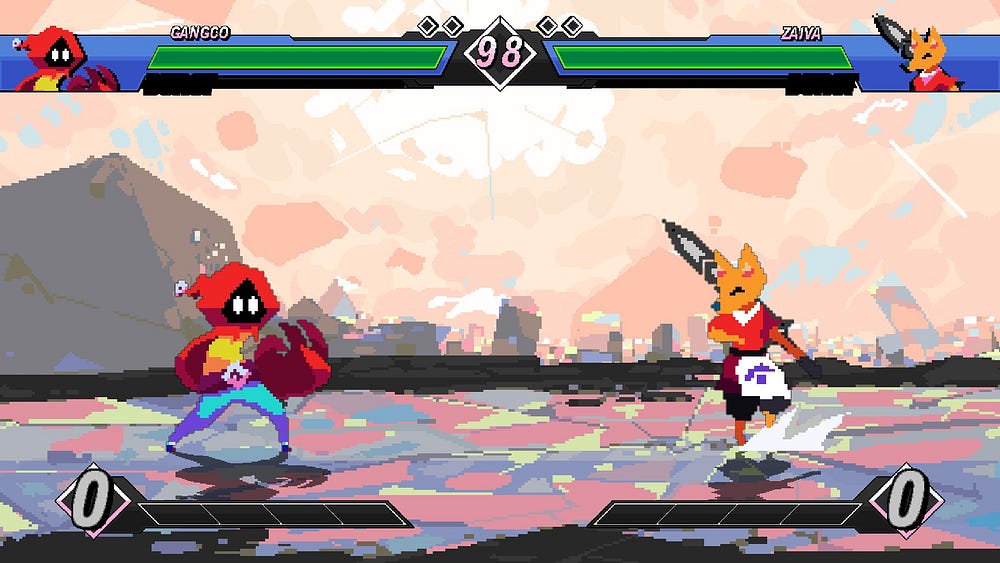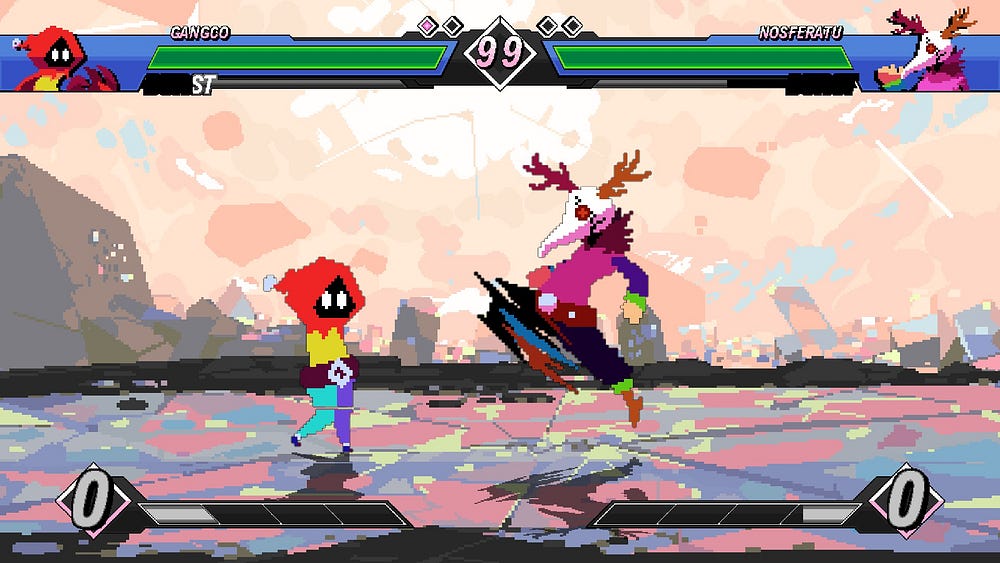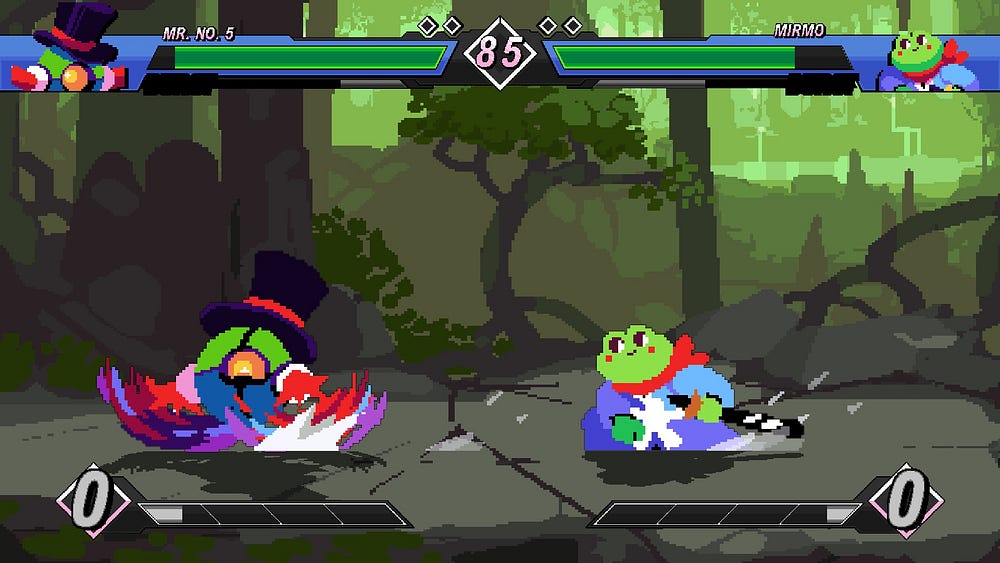This article is part of my ongoing “Indie Fighting Game Thursday” review/retrospective series, now debuting on supercombo.gg! This week we talk about Arcus Chroma, a colorful, 2D pixel art game available on itch.io in early access!
Fighting games are generally known for complex inputs, long combos, or very unforgiving first impressions, which necessitate of long, wordy tutorials just to teach the players the basics. True, one can go “push buttons, see what happens”, but this approach can only take you so far.
A bunch of games in the last few years have embraced simplification, in their own unique ways: some, like Under Night In-Birth and Dragon Ball FighterZ, added autocombos, triggered by repeated presses of a single button; some, like Power Rangers: Battle for the Grid, removed motion inputs in favor of simple “direction plus button” combinations, and some, like Fantasy Strike, removed crouching altogether and added features like automatic throw breaks if the opponent is idle and not pressing anything.
In the single developer/small team of developers field, prominent examples of making a game more casual-friendly can be seen in Beatdown Dungeon, with its autocombos and simplified special inputs, MerFight, with its optional simple controls, and FOOTSIES, which brought everything down to an extremely minimalistic level.
Today, we analyze another entry in this series of “beginner-friendly” indie fighting games, which — in terms of complexity — comfortably sits somewhere between HYPERFIGHT and Beatdown Dungeon: a little, still-to-be-polished gem called Arcus Chroma, developed by GxGrain Son!

Colorful characters, colorful stages, and a combo-monster-sword-fox that made me swear against the AI with words better suited for a different kind of article.
A colorful world of pixels
First a disclaimer: this game is still in early access and is missing a lot of planned features. This review will cover the latest public demo, version 0.6.8, published in November 2020, and available for purchase on itch.io.
The “unfinished” nature of the game is pretty evident, both in the menu design — teasing modes that aren’t implemented yet — and in the character sprites, which occasionally miss shading and have some parts (like capes) disappearing. Despite all of the above, the direction is clear and very promising: the art style is solid, the characters are simple yet effective, and animations have the correct amount of weight. Hits and moves have a proper set of sound effects, and there is already a couple unique songs as a soundtrack. The package is barebones, but complete enough to start building an opinion on the game and — more importantly — on how it plays.

Arcus Chroma has a peculiar graphic style that sets it easily apart from the competition: The ten characters available for selection are all extremely colorful and unique.
A freeform combo system
The game uses six buttons: light attack, medium attack, heavy attack, spot dodge, grab and burst. Light attacks can be seamlessly chained into medium and then heavy attacks on hit. On block, some attacks will instead play their whole animation, becoming extremely punishable if used carelessly.
There are also some command moves performed by pressing up, down or down-forward plus the medium or heavy attack button: among those, up plus medium attack is an universal overhead that cannot be blocked while crouching.
Once per combo or per block string, it is also possible to use again a move of lower strength (e.g. a light attack after a heavy), effectively performing what in Under Night In-Birth is called a “reverse beat”.
Special moves are universally performed by inputting a quarter circle forward or backwards plus the light or medium attack button. Each character has two specials, with two variations each depending on the button pressed.
Each character has also access to two super moves: quarter circle forward plus heavy attack costs one bar of super meter, while quarter circle backwards plus heavy attack costs two bars of super meter and deals more damage.
Grabs are performed with the dedicated button. By pressing a direction (forward or backwards) during the startup of a successful grab, one can decide where to throw the opponent.

The game is still unfinished, which becomes clear when looking at some in-between frames, missing shading and capes. Despite this, the on-hands feeling is wonderful and one can already imagine which direction the art department is following.
No permission to take off
So far, the setup doesn’t seem too different from the usual fighting game kit, but here’s where things become interesting: Arcus Chroma has no jump.
Yes, this isn’t a mistake on my side and you have read it correctly: Neither by pressing up, nor by pressing a button, any character will perform a jump arc of any sort: all of them are solidly stuck to the ground — which, from a programming standpoint, is a very clever trick to avoid dealing with edge cases of airborne corner collisions.
Characters can still be juggled during combos and performing the universal overhead puts them in a sort of airborne state, but aside from this and some special moves, there is no other way to soar the skies. Much like FOOTSIES, the movement is only on the horizontal axis, removing the emphasis on anti-airs and jump-ins.
In exchange for the missing vertical movement, we get a spot dodge button, which can be used to have a brief window of invincibility and evade an incoming attack and — when pressed with a direction button — to zoom forward or backward in a semi-invulnerable twist-y step. This “dodge step” also allows to move through the opponent, effectively becoming a way to escape corner pressure or to switch side.

RUN, MR. NO. 5! MIRMO IS COMING!
Defense and offence
Defense in Arcus Chroma is fairly standard: you press back or down-back to block attacks, keeping an eye on the attack type. The universal overhead attack cannot be blocked while crouching, while many crouching attacks cannot be blocked standing.
There is a burst that doubles as an universal cancel option and can only be performed when the Burst bar under the life bar is full. The bar starts empty and is filled by waiting long enough or taking damage from the opponent.
While blocking the opponent’s attacks, one can also press a direction plus the dodge button to perform a sort of “guard evade/guard cancel” for the cost of one super stock.
The super meter is divided into four stocks, and it is gained by dealing or receiving damage. However, as of the current build of the game, the rate of meter gain is quite slow and it is rather uncommon to have four stocks at one’s disposal at the end of one round.

Universal overheads are pretty fast and hard to react to. Better be on your toes and wait for one, while guarding.
In the hands of a newcomer
What makes Arcus Chroma feel good is the responsiveness and immediateness of its gameplay. The hitstun is right, the screen-shake and impacts are great. Characters zoom around the screen at the press of a button, and the animations sell the hits wonderfully. But I know I am biased, as I cannot be called a complete beginner or newcomer to the genre anymore: I am pretty well versed in fighting games and have tried many of them, too many to count. To work around this and get some meaningful feedback on how it feels for someone with less experience, I have performed a rather simple test: I have put the game in the hands of someone who doesn’t play fighting games often.
Last year, I brought a good amount of indie fighting games on my laptop PC back to my parents’ place and asked my brother — a Metroidvania/Devil May Cry avid player with just a passing interest in fighting games — to try out all of them. To make the experiment even more reliable with respect to approachability, we skipped all tutorials and went directly to the “meat and potatoes”.
I won’t list all the games I put in his hands out of respect for my fellow developers, because his comments ranged from “burn it with fire” to “potentially interesting, but it feels VERY sluggish and stiff”. He also thrashed the movement in my own game Schwarzerblitz as sluggish (“when I press a direction, I want my character to move, not to limp or make tiny little steps”), so not even I was spared by his judgement.
One single game, however, passed with flying colors: if you haven’t guessed it, it’s precisely Arcus Chroma.
He just needed a couple minutes to start learning the game and punishing me with Mirmo’s counter attacks (silly me, what was I expecting from a PSP Final Fantasy Dissidia Exdeath player?), commenting on how responsive and intuitive the game felt, even without a proper tutorial, and being positively impressed by the visuals and general cleanliness of the UI. Among the games I showed him and let him try, no other one impressed him as much as that, which I believe can be considered a testament to its low entry barrier.

Hitboxer is a guest from another one of GxGrain Son’s games, Hyper Hitboxing.
A playstyle for everyone
The current cast of Arcus Chroma counts ten characters. There are rushdown monsters like Zaiva, that can teleport around the stage at breakneck speed, and Skullion, with a wealth of oppressive approaching tools; mixup-heavy characters like Gangco; slow heavy hitters with zoning tools like Manta, fast ninjas with teleports like Kern; weird setup characters like Mr. №5 and oki/control based characters like Ciel. Some characters like Hitboxer and Mirmo have access to very solid counter attack stances. A separate discussion must be done for the grappler of the game, Nosferatu, that — in a game without jumps — is one of the scariest thing I have faced so far. I still have to find a way to avoid his tick throws, as I haven’t delved into the specifics of his attacks too much, for now, but he could indeed be hard to deal with for newcomers.

By pressing Select/Back in training mode, the hitboxes become visible, helping a lot with the labbing experience.
What’s in the package?
Arcus Chroma is pretty barebones, as it stands now. There is a Training mode (but without additional options, except for a very handy hitbox viewer), there is a local versus mode, a Player vs AI mode, and an AI vs AI spectator mode. The AI is fairly challenging, with some characters being harder than other. Zavia’s AI is brutal for a casual player, and Nosferatu can make grown men cry, at times. The AI has also the unnerving trait of being able to “read” throw attempts and dash back as soon as I input the grab buttons, but it’s overall pretty fun to challenge.
How to play it
Arcus Chroma is sold on itch.io in Early Access for 10.00 USD, and includes any future update the game will receive. It has currently no netcode, but can be played online using middleware like Parsec. The game has an official Discord server, directly managed by the developer.
Game summary
Name of the game: Arcus Chroma
Developer: GxGrain Son
Available on: PC (itch.io)
Price: 10.00 USD
Year of release: in progress (current version as of September 2021: 0.6.3)
Engine: Unity
Netcode: none (Parsec)
Status: early access
In one sentence: 2D colorful pixel art fighter with simple controls and no jump, but with a promising future as an immediate, responsive game.
Special thanks to Luca “Zangobot” Demetrio for being my test subject in trying out all those indie fighting game and giving me a reason to like Arcus Chroma even more.
If you are interested in more coverage about indie fighting games, you can find me on Twitter at @AndreaDProjects

